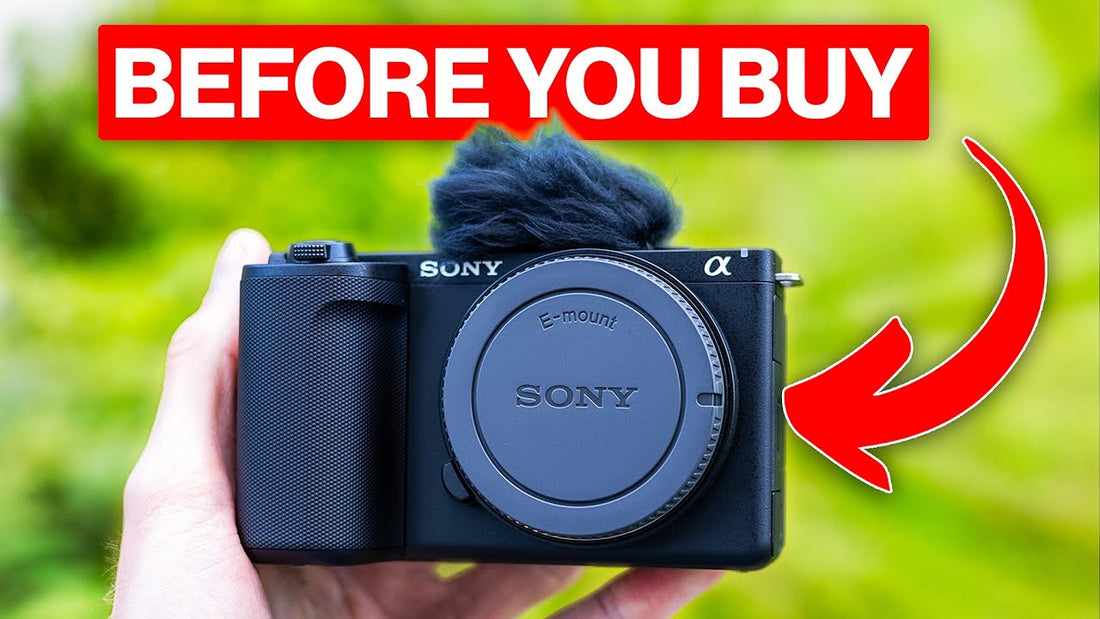
Sony ZV-E10 II: 7 Things To Know BEFORE You Buy!
Check out my full video HERE
This post contains affiliate links. If you click and make a purchase, I may earn a commission at no extra cost to you. Thanks for your support!
Introduction
If you’ve been thinking about snagging the Sony ZV-E10 II, you’re in good company. This camera is attracting a lot of buzz, especially among creators looking for a sleek, portable rig. But before you commit, it’s worth knowing some key details—both the pleasant surprises and the annoying little quirks. Let’s walk through seven important points so you’ll know exactly what you’re getting into.
1. Bigger Battery for Longer Shoots
One of the first things you’ll notice is the switch to the larger FZ100 batteries.
- Upside: Much better battery life, meaning fewer interruptions and missed shots.
- Downside: If you’re coming from older APS-C models (like the original ZV-E10), you won’t be able to use your old FW50 batteries. You’ll need to invest in new ones.
My Take: This upgrade is worth it, but make sure you budget for extra batteries since your old stash is now obsolete.
2. No EVF: Relying on the Screen All the Time
Without an electronic viewfinder, you’re stuck with the flip-out screen.
- Great Indoors: The fully articulating touchscreen is excellent in controlled lighting or for vlogging.
-
Struggle Outdoors: In bright sunlight, it’s challenging to see the screen clearly.
My Take: If you mainly shoot video or work in stable lighting conditions, you might not mind. But hardcore photographers could find this frustrating.
3. No Charger Included, Seriously?
Sony gives you a battery in the box, but failed to include a charger or EVEN a basic USB-C cable.
My Take: This is a head-scratcher. Before your camera arrives, double-check that you have a USB-C cable on hand, or you’ll be running out to the store sooner than you’d like.
4. High-Quality Video Demands Fast SD Cards
To take advantage of 4K 10-bit 4:2:2 recording, you’ll need a UHS-II SD card.
- Why It Matters: Standard cards might choke on these high data rates.
- Extra Cost: UHS-II cards are pricier, but they unlock the camera’s full video capabilities.
My Take: If you’re a video creator who wants top-notch footage, factor in the cost of a premium SD card.
5. A Minor Crop at 4K 60p
Shooting at 4K/60fps adds a 1.1x crop.
-
Not Huge, But Noticeable: Your ultra-wide shots will feel just a bit tighter.
My Take: This won’t ruin your day, but if you love wide-angle vlogging, consider a slightly wider lens than usual.
6. Hidden Dual Base ISO for Cleaner Images
The ZV-E10 II inherits dual base ISOs (800 and 2500 in S-Log3) from higher-end Sony models.
-
What It Means: Exceptionally clean footage at these two ISO values, giving you flexibility in various lighting conditions.
My Take: For those who shoot a lot in changing light, this is a significant plus, providing better low-light performance and more versatile shooting.
7. Stabilization Isn’t Perfect
There’s no in-body image stabilization (IBIS), so it’s digital-only.
- Trade-Off: Turning stabilization on crops your image further, stacking on top of the 4K 60p crop.
- Solution: Use lenses with optical stabilization or start with a very wide lens to maintain a comfortable field of view.
My Take: Vloggers who crave smooth, wide shots will need to get creative with their lens choices or accept a tighter frame.
Final Thoughts
The Sony ZV-E10 II is a strong contender if you know what to expect. It offers improved battery life, top-quality video options, and excellent low-light performance, but also comes with a few surprises—no EVF, no included charger, and a need for pricier SD cards. Keep these points in mind, and you’ll head into your purchase with a clear, realistic perspective.

1 comment
I bought this, but unfortunately my copy doesn’t clean up at 2500 in slog3, and it’s not advertised to have a second base iso, hower some copies seem to have it